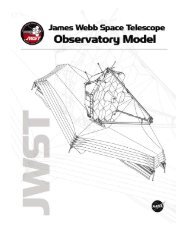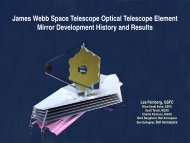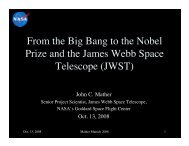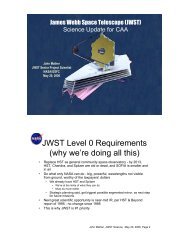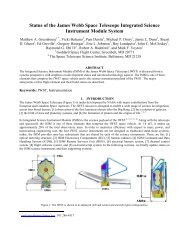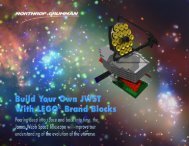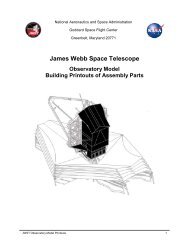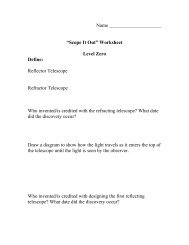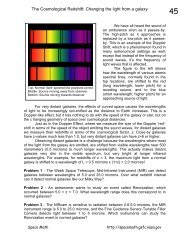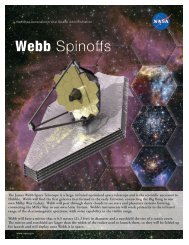Model Parts. - James Webb Space Telescope - NASA
Model Parts. - James Webb Space Telescope - NASA
Model Parts. - James Webb Space Telescope - NASA
You also want an ePaper? Increase the reach of your titles
YUMPU automatically turns print PDFs into web optimized ePapers that Google loves.
The <strong>James</strong> <strong>Webb</strong> <strong>Space</strong> <strong>Telescope</strong> (JWST) is a large, infrared-optimized space telescope, scheduled for<br />
launch in 2014. JWST will find the first galaxies that formed in the early Universe, connecting the Big Bang<br />
to our own Milky Way Galaxy. JWST will peer through dusty clouds to see stars forming planetary<br />
systems, connecting the Milky Way to our own Solar System. JWST's instruments will be designed to<br />
work primarily in the infrared range of the electromagnetic spectrum, with some capability in the visible<br />
range.<br />
JWST will have a large mirror, 6.5 meters (21.3 feet) in diameter and a sunshield the size of a tennis court.<br />
Both the mirror and sunshade won't fit onto the rocket fully open, so both will fold up and open once<br />
JWST is in outer space. JWST will reside in an orbit about 1.5 million km (1 million miles) from the Earth.<br />
JAMES WEBB SPACE TELESCOPE<br />
21.3’ (6.5m) dia mirror<br />
1:48 scale http://www.jwst.nasa.gov/
<strong>James</strong> <strong>Webb</strong> <strong>Space</strong> <strong>Telescope</strong> – 1:48 scale<br />
The star tracker takes sightings of reference stars<br />
to keep track of where the telescope is pointing.<br />
1-<strong>Space</strong>craft Bus Assembly<br />
FOLD UP<br />
STAR TRACKER<br />
FOLD UP<br />
MAIN BUS<br />
STAR<br />
TRACKER<br />
STAR SENSORS<br />
bond paper<br />
ROLL<br />
ROLL-THEN CUT<br />
ONE SQUARE END<br />
CYLINDER. CUT<br />
REMAINDER IN HALF<br />
AT 45 DEGREES<br />
FOLD UP<br />
DO NOT FOLD USE TO<br />
ATTACH FORE/AFT<br />
SUNSHIELD SUPPORT<br />
BEAMS<br />
The spacecraft bus houses the equipment<br />
that runs the satellite: keeping the<br />
batteries charged; pointing the<br />
telescope/spacecraft at the target<br />
stars; etc.<br />
CUT<br />
PRIMARY<br />
REFLECTOR<br />
FOLD UP<br />
FOLD UP<br />
HGA<br />
SECONDARY<br />
REFLECTOR<br />
TRIPOD<br />
The high gain antenna is used to receive commands from,<br />
Copyright 2010: John Jogerst.<br />
and return the telescope’s observations to, the Earth.<br />
Not for commercial use.<br />
For educational or personal use only.<br />
ROLL<br />
HGA MOUNT<br />
MOUNT TO BLUE SQUARE ON BUS<br />
BUS END<br />
FOLD ARMS INTO<br />
BEAMS, REINFORCE<br />
ELBOW WITH ROLL<br />
DISH END
<strong>James</strong> <strong>Webb</strong> <strong>Space</strong> <strong>Telescope</strong> – 1:48 scale<br />
8-Secondary Mirror Assembly<br />
2-Solar Arrays<br />
AFT EDGE OF BUS AND AFT END OF SOLAR SHIELD<br />
MOMENTUM FLAP<br />
The momentum flap helps stabilize the<br />
spacecraft. JWST is so precise that solar<br />
pressure on the large sunshields can<br />
actually rotate (slowly) the telescope, spoiling<br />
its aim. The flap adjusts to counteract part of<br />
this pressure to help keep the telescope view<br />
steady.<br />
Copyright 2010: John Jogerst. Not for commercial use.<br />
For educational or personal use only.<br />
The solar panel generates the power<br />
that runs the satellite and the telescope<br />
instruments.<br />
SECONDARY MIRROR<br />
SUPPORT STRUTS<br />
2 OF 3
<strong>James</strong> <strong>Webb</strong> <strong>Space</strong> <strong>Telescope</strong><br />
1:48 scale<br />
STAR SENSORS<br />
Option: print on<br />
bond paper<br />
3-Sunshields<br />
#5 bottom aft end<br />
Master Pattern<br />
PRINT THIS ON<br />
PLAIN BOND PAPER<br />
ROLL<br />
ROLL-THEN CUT<br />
ONE SQUARE END<br />
CYLINDER. CUT<br />
REMAINDER IN HALF<br />
AT 45 DEGREES
<strong>James</strong> <strong>Webb</strong> <strong>Space</strong> <strong>Telescope</strong><br />
1:48 scale<br />
3-Sunshields<br />
#5 bottom fore end<br />
Master Pattern<br />
The sunshields keep the satellite cool by<br />
blocking the heat of the sun. This allows<br />
the JWST’s infra-red telescope to see<br />
and analyze very faint, distant objects.<br />
Since the JWST “sees” in infra-red light<br />
(heat), it must be kept very cold or the<br />
heat from the spacecraft itself would<br />
obscure its view.<br />
PRINT THIS ON<br />
PLAIN BOND PAPER<br />
STAR<br />
TRACKER
<strong>James</strong> <strong>Webb</strong> <strong>Space</strong> <strong>Telescope</strong><br />
1:48 scale<br />
3-Sunshields<br />
#4 aft end<br />
Master Pattern<br />
PRINT THIS ON<br />
PLAIN BOND PAPER
<strong>James</strong> <strong>Webb</strong> <strong>Space</strong> <strong>Telescope</strong><br />
1:48 scale<br />
3-Sunshields<br />
#4 fore end<br />
Master Pattern<br />
PRINT THIS ON<br />
PLAIN BOND PAPER
<strong>James</strong> <strong>Webb</strong> <strong>Space</strong> <strong>Telescope</strong><br />
1:48 scale<br />
3-Sunshields<br />
#3 mid aft end<br />
Master Pattern<br />
PRINT THIS ON<br />
PLAIN BOND PAPER
<strong>James</strong> <strong>Webb</strong> <strong>Space</strong> <strong>Telescope</strong><br />
1:48 scale<br />
3-Sunshields<br />
#3 mid fore end<br />
Master Pattern<br />
PRINT THIS ON<br />
PLAIN BOND PAPER
<strong>James</strong> <strong>Webb</strong> <strong>Space</strong> <strong>Telescope</strong><br />
1:48 scale<br />
3-Sunshields<br />
#2 aft end<br />
Master Pattern<br />
PRINT THIS ON<br />
PLAIN BOND PAPER
<strong>James</strong> <strong>Webb</strong> <strong>Space</strong> <strong>Telescope</strong><br />
1:48 scale<br />
3-Sunshields<br />
#2 fore end<br />
Master Pattern<br />
PRINT THIS ON<br />
PLAIN BOND PAPER
<strong>James</strong> <strong>Webb</strong> <strong>Space</strong> <strong>Telescope</strong><br />
1:48 scale<br />
3-Sunshields<br />
#1 top aft end<br />
Master Pattern<br />
PRINT THIS ON<br />
PLAIN BOND PAPER
<strong>James</strong> <strong>Webb</strong> <strong>Space</strong> <strong>Telescope</strong><br />
1:48 scale<br />
3-Sunshields<br />
#1 top fore end<br />
Master Pattern<br />
PRINT THIS ON<br />
PLAIN BOND PAPER
<strong>James</strong> <strong>Webb</strong> <strong>Space</strong> <strong>Telescope</strong> – 1:48 scale<br />
3-Sunshields<br />
MOUNTING TABS<br />
SPREADER BARS – cut cross beam bars short to achieve angle of sunshade<br />
The spreader bars hold the five sunshield layers apart<br />
to increase their insulating effectiveness.
<strong>James</strong> <strong>Webb</strong> <strong>Space</strong> <strong>Telescope</strong> – 1:48 scale<br />
Do not bend black “ears” on end-used to attach to spreader bars.<br />
AFT<br />
4-Sunshield support beams – trim ends if needed to butt<br />
with spacecraft bus assembly<br />
The sunshield support<br />
beams are the “bones” that<br />
hold the sunshields in<br />
position. Folded for launch,<br />
they unfold in space to<br />
stretch out the sunshields.<br />
AFT<br />
FORE<br />
The center support boom is the<br />
backbone that connects the<br />
satellite bus to the instruments<br />
and telescope.<br />
FORE<br />
CROSSBEAM<br />
CROSSBEAM<br />
5-Center<br />
Support Boom
<strong>James</strong> <strong>Webb</strong> <strong>Space</strong> <strong>Telescope</strong> – 1:48 scale<br />
6-Integrated Science Instrument Module (ISIM)<br />
8-Secondary Mirror Assembly<br />
SECONDARY MIRROR<br />
SUPPORT STRUT<br />
1 OF 3<br />
IEC<br />
The ISIM contains the telescope’s science<br />
instruments that will observe and analyze<br />
distant objects. Instruments include:<br />
Near InfraRed Camera (NIRCam),<br />
Near InfraRed Spectrograph (NIRSpec),<br />
Mid-InfraRed Instrument (MIRI),<br />
and the Fine Guidance Sensor Tunable Filter Camera (FGS-TFI)<br />
The support struts hold the secondary mirror precisely in position<br />
to reflect light from the primary mirror to the science instruments.<br />
They are folded for launch and unfold in space.
<strong>James</strong> <strong>Webb</strong> <strong>Space</strong> <strong>Telescope</strong> – 1:48 scale<br />
6-Integrated Science Instrument Module 7-Primary Mirror<br />
INSTRUMENT SHIELD<br />
PRIMARY MIRROR<br />
The primary mirror collects infrared light for the science<br />
instruments. A 6.5 meter (21’ 4”) mirror makes JWST<br />
the most powerful space telescope. JWST uses infrared<br />
light (heat) to see objects at the very edge of our<br />
visible universe.<br />
ISIM Electronics Compartment (IEC)<br />
TOP<br />
The IEC contains electronic equipment<br />
that generates heat when operating,<br />
so they must be isolated from the<br />
science instruments.<br />
Hubble <strong>Space</strong> <strong>Telescope</strong><br />
mirror to scale
MIRROR FRONT SURFACE<br />
The JWST mirror is so large it must be folded to fit into its<br />
launch rocket. The three mirror segment in the outer rows<br />
are folded back for launch, then unfolded into precise<br />
alignment once JWST is in space. The mirror segments are<br />
held in place by an intricate truss – the backplane.<br />
MIRROR BACK SURFACE<br />
These rows fold back for launch.
<strong>James</strong> <strong>Webb</strong> <strong>Space</strong> <strong>Telescope</strong> – 1:48 scale<br />
REVISED BACKPLANE - FRONT<br />
For a detailed scratch-build, refer to pictures and<br />
the JWST web site.<br />
Backplane structure is truss of box beams.<br />
Mirror mounts are welded, tube structures.<br />
Outer column of 3 mirrors folds back for<br />
launch.<br />
Shield is thin sheet.<br />
Secondary mirror support struts<br />
mount to pads on backplane truss<br />
behind shield.<br />
For detailed primary mirror,<br />
cut out dotted<br />
circle and inset<br />
the curved<br />
mirror.<br />
The JWST backplane actually consists of a truss structure attached<br />
to the ISIM (black rectangular shape on part); the mirror supports<br />
(oval structures on part); thermal shields on the back of the mirror<br />
supports and a shielding panel at the bottom that prevent heat from<br />
the ISIM and IEC from reaching the mirrors. This part has been simplified<br />
to make it easier to build.
<strong>James</strong> <strong>Webb</strong> <strong>Space</strong> <strong>Telescope</strong> – 1:48 scale<br />
REVISED BACKPLANE - BACK<br />
GLUE 2ND<br />
For a detailed scratch-build, refer to pictures and<br />
JWST web site.<br />
Backplane structure is truss of box beams.<br />
Protective covers over attachments.<br />
8-Secondary Mirror Assembly<br />
AFT OPTICS –<br />
CENTER ON<br />
FACE OF MIRROR<br />
The secondary mirror takes the light<br />
focused by the primary mirror and<br />
sends it back to the instruments<br />
through the aft optics.<br />
GLUE THIS FIRST



